Hey, fashion lovers! If you are someone who believes in making bold fashion choices with a touch of tradition, then you’re about to fall in love with Muga silk, Assam’s golden treasure. Known for its natural golden sheen, incredible durability, and rich cultural legacy, Muga silk is not just a fabric—it’s a statement.
Imagine something as luxurious as Italian silk or French chiffon—but rooted deep in Indian soil. Muga silk is that rare jewel—a symbol of timeless beauty that shimmers brighter with age. Worn once only by royalty, it’s now making waves as an eco-luxury fabric for modern professionals who want to dress sustainably without compromising on style.
But why is Muga silk called the “Fabric of the Gods”? How did this ancient weave from Assam find its way into boardrooms and global fashion ramps? Let’s explore.
The Legacy of Muga Silk: History and Heritage
2000 Years of Golden Glory
Muga silk has been a part of Assamese culture for over 2000 years, tracing back to ancient dynasties and indigenous communities who nurtured this exquisite art. Once reserved exclusively for kings and queens, it was worn during coronations, festivals, and ceremonial events.
Royal Sheen and Heritage Value
What sets Muga apart? Its natural golden hue doesn’t require dyeing—and what’s more fascinating is that it grows brighter with age. It’s not just a piece of clothing; it’s an heirloom, often passed down through generations, rich with stories and history.
Even today, Muga silk is woven by skilled Assamese artisans using time-honored methods. From the silkworms nurtured in the lush wilds of Assam to the final weave on handlooms—every thread is crafted with devotion.
The Eco-Luxury Element: Sustainability Meets Style
Nature’s Finest, Fashion’s Future
Muga silk is more than a luxurious fabric—it’s a beacon of sustainability in an age of fast fashion. Unlike synthetic textiles, Muga silk is:
- 100% natural and biodegradable
- Produced without harmful chemicals or dyes
- Exceptionally durable, often lasting for over 100 years
A saree today can become an heirloom tomorrow.
Sustainable Style for Urban Lives
For today’s eco-conscious urban professionals, Muga silk offers a unique proposition—style that’s ethical, durable, and deeply rooted in culture. In a world drowning in disposable fashion, Muga stands tall as a timeless and responsible choice.
Craftsmanship: The Art of Weaving Muga
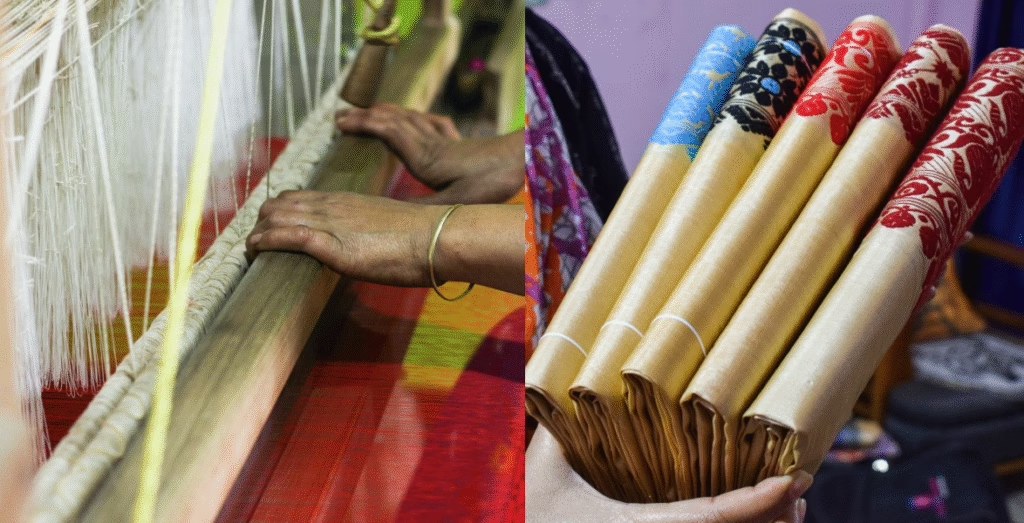
Muga silk weaving is a deeply traditional, artisanal craft that reflects the soul of Assam. The process is slow, meticulous, and requires immense skill—especially from the women weavers who have preserved this heritage for generations. From nurturing silkworms to the final woven masterpiece, each step is a labor of love and a testament to timeless craftsmanship.
Materials Used in Muga Silk Weaving
- Muga Silkworms (Antheraea assamensis): Indigenous to Assam, these silkworms feed on specific host plants.
- Host Plants:
- Som (Machilus bombycina)
- Soalu (Litsaea polyantha)
These plants provide the essential leaves for the silkworms to thrive.
- Som (Machilus bombycina)
- Natural Dyes (Occasionally Used): Although Muga’s natural golden sheen needs no dye, some artisans use plant-based dyes for added design work.
- Traditional Handlooms: Wooden looms passed down through generations, often operated at home.
- Cotton Threads (Optional): Occasionally used as warp or for blending in mixed fabric creations.
Step-by-Step Process of Making Muga Silk
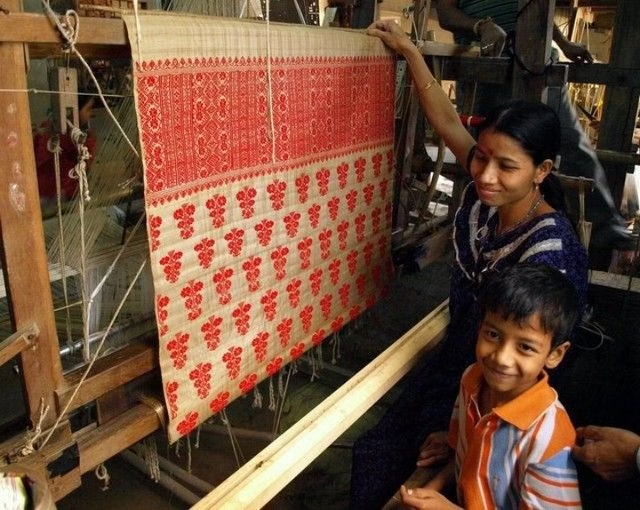
1. Rearing the Silkworms
- Silkworm eggs are hatched, and larvae are fed fresh Som or Soalu leaves.
- They undergo five moltings before spinning golden cocoons.
- Rearing is usually done by local families, often women-led.
2. Harvesting and Boiling the Cocoons
- Once mature, cocoons are carefully collected.
- They’re boiled to extract the silk filament, a process done gently to retain fiber strength and sheen.
3. Reeling the Silk
- The silk is reeled by hand—a delicate process that separates the long filaments from the cocoon.
- Muga filaments are naturally golden, needing no artificial treatment.
4. Spinning and Thread Making
- Silk threads are hand-spun into yarns, often on traditional spinning wheels.
- This stage requires precision to ensure thread consistency and durability.
5. Weaving on Traditional Looms
- Artisans, mostly women, weave the silk on handlooms at home.
- Designs include floral motifs, traditional Assamese patterns, and geometric borders.
- Weaving can take weeks or months, depending on the intricacy.
Symbols and Motifs in Muga Silk: Stories Woven in Golden Threads
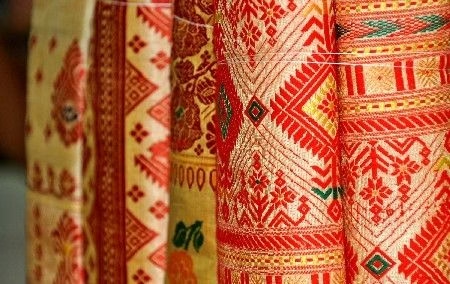
Muga silk is not just a fabric; it is a canvas that carries centuries of Assamese culture, tradition, and symbolism. The motifs woven into Muga are rich in meaning, each telling a story of nature, spirituality, and everyday life. These designs are carefully handloomed by skilled artisans, ensuring that every thread embodies the heritage of Assam. Let’s explore the most iconic motifs and their significance.
1. Nature-Inspired Motifs
Muga silk often draws inspiration from the natural world, reflecting the close connection between Assamese culture and its environment.
- Floral Patterns: Common motifs include lotus, hibiscus, and marigold, representing purity, beauty, and auspiciousness.
- Fauna Representations: Animals like elephants, peacocks, and fish appear frequently, symbolizing strength, grace, and abundance.
- Leaf and Vine Designs: Continuous vine patterns symbolize growth, continuity, and prosperity, frequently adorning borders of sarees and garments.
2. Religious and Spiritual Motifs
Many Muga silk motifs are deeply rooted in Assamese spirituality, reflecting devotion and cultural rituals.
- Gamosa Motifs: Inspired by Assam’s traditional towel, these patterns are symbolic of respect and cultural pride.
- Conch Shells and Lotus Symbols: Represent divine energy and enlightenment, often woven into ceremonial attire.
- Radha-Krishna Inspired Patterns: These motifs celebrate love, devotion, and mythological heritage, tying garments to Assamese religious traditions.
3. Geometric and Tribal Motifs
Assam’s tribal communities have influenced Muga weaving with distinctive geometric patterns.
- Zigzag and Chevron Lines: Symbolize continuity, rhythm, and life cycles.
- Triangles and Diamonds: Represent fertility, strength, and protection against negative energies.
- Checkerboard and Lattice Designs: Used for both aesthetic appeal and symbolic harmony in clothing.
4. Contemporary Interpretations
Modern designers have adapted traditional motifs to create urban-friendly Muga silk wear while preserving cultural integrity.
- Simplified floral and geometric patterns are used in scarves, jackets, and formal attire.
- Abstract nature-inspired motifs bring versatility for office wear and professional settings.
- Combining traditional and minimalistic motifs allows Muga silk to appeal to eco-luxury enthusiasts globally.
Muga Silk in Modern Wardrobes: Fashion for Urban Professionals
Heritage That Hustles
Gone are the days when Muga silk was limited to traditional sarees. Today, it’s reinventing itself for the modern wardrobe:
- Elegant dresses
- Office-ready jackets and scarves
- Power ties and kurtas
- Fusion wear that blends East and West
Urban professionals are embracing Muga as power dressing—elegant, confident, and environmentally responsible.
From Runway to Boardroom
Designers like Sanjukta Dutta and eco-conscious brands are experimenting with Muga, showcasing its versatility on global fashion runways. It’s more than just attire—it’s a story you wear, a heritage you carry into your daily life.
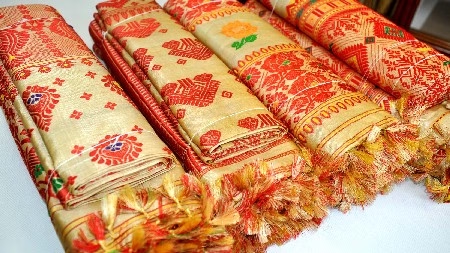
Challenges Facing Muga Silk
Muga silk, Assam’s golden treasure, faces several challenges despite its unmatched beauty, heritage, and eco-friendly appeal. Understanding these obstacles is crucial for preserving this ancient craft for future generations.
1. Declining Number of Artisans
- The number of skilled Muga silk weavers has been steadily declining due to migration, low income, and younger generations opting for alternative careers.
- Did You Know? Only about 15,000 families in Assam are actively involved in Muga silk weaving today, compared to over 50,000 two decades ago.
2. Environmental and Agricultural Challenges
- Muga silkworms feed exclusively on Som and Soalu leaves. Deforestation, urbanization, and climate change threaten the availability of these trees, directly impacting silk production.
- Did You Know? A single Muga silkworm cocoon produces around 2–3 grams of silk, making the process highly dependent on healthy ecosystems.
3. High Production Costs
- The labor-intensive handloom process, long rearing cycles, and low yield make Muga silk products expensive, limiting their accessibility in broader markets.
- Did You Know? The cost of a 1-meter Muga silk fabric can range between $50 and $100, much higher than other silk varieties.
4. Market Awareness and Competition
- Many consumers, especially urban buyers, are unaware of Muga silk’s unique qualities. Synthetic fabrics and cheaper silk alternatives dominate both domestic and global markets.
- Did You Know? Less than 10% of Indian consumers can correctly identify Muga silk compared to Eri or Tussar silk.
5. Preservation of Traditional Techniques
- Maintaining age-old weaving and dyeing techniques is a challenge as modernized methods and mechanization tempt artisans. Passing down authentic skills to younger generations is critical.
Did you know?
Muga silk production is so rare that only a few hundred kilograms are produced annually, making it even more exclusive—but also vulnerable.
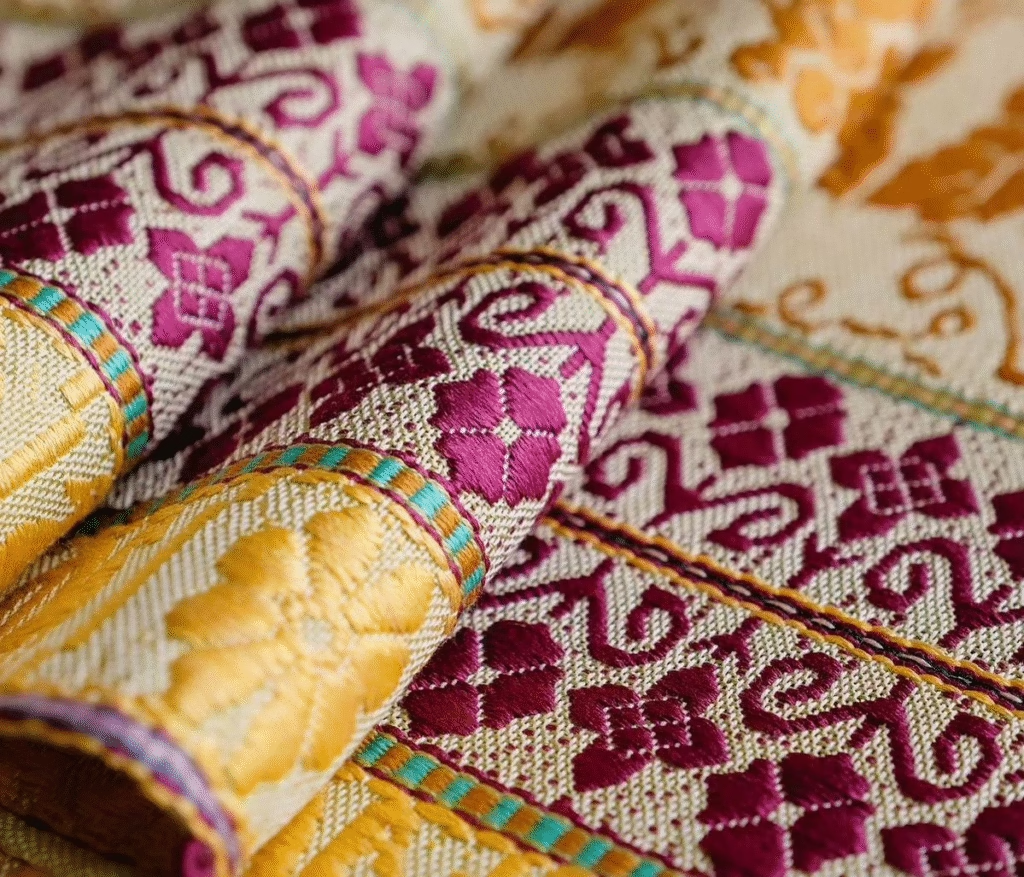
Revival and Global Recognition of Muga Silk
Muga silk, the golden treasure of Assam, has experienced a remarkable resurgence in recent years. This revival is a testament to the concerted efforts of various stakeholders, including the government, artisans, and fashion enthusiasts, who have worked tirelessly to restore its prominence on the global stage.
1. Government Initiatives and Support
- Muga Mission: The Assam government launched the Muga Mission to enhance cocoon and raw silk production, provide infrastructure and training, and promote market linkages. This initiative aims to transform the rural economy of Assam by facilitating the emergence of a vibrant silk industry through the application of technology, motivation, and demonstration.
- Som Tree Plantation Drives: Recognizing the importance of Som trees (Persea Bombycina) in Muga silk production, the Lakhimpur district administration in Assam launched a plantation drive by planting 1,500 saplings on a 10-bigha plot in Phukanarhat village. This initiative aims to support and strengthen the traditional Muga silk industry, which relies heavily on Som trees as the primary food source for the Muga silkworm.
2. Cultural and Economic Significance
- Cultural Identity: Muga silk is deeply intertwined with Assam’s cultural identity. It is used in traditional garments like Mekhela Chador and is an essential part of Assamese festivals and rituals.
- Economic Impact: The Muga silk industry provides livelihoods to thousands of families in Assam. The revival efforts have led to increased employment opportunities in rural areas, contributing to the state’s economic development.
3. Global Recognition and Market Expansion
- Geographical Indication (GI) Status: In 2007, Muga silk was granted Geographical Indication (GI) status, signifying its unique origin in Assam and protecting its authenticity. Wikipedia
- International Demand: The unique properties of Muga silk, such as its natural golden hue and durability, have attracted international buyers. Exporters have reported a steady increase in demand from countries in Europe, North America, and East Asia.
- Fashion Industry Collaboration: Fashion designers and brands are increasingly incorporating Muga silk into their collections, recognizing its luxury appeal and sustainable attributes. Collaborations with international fashion houses have further elevated its status in the global market.
4. Challenges and Sustainability Efforts
- Environmental Concerns: The cultivation of Som trees, essential for Muga silkworms, faces challenges due to deforestation and climate change. Conservation efforts are being implemented to ensure a sustainable supply of these trees.
- Market Competition: Muga silk competes with other silk varieties in the global market. Efforts are being made to highlight its unique qualities and establish a distinct market niche.
- Skill Development: Training programs for artisans are being conducted to enhance weaving techniques and design innovation, ensuring the production of high-quality Muga silk products.
5. Future Prospects
- Research and Development: Ongoing research aims to improve the sericulture process, enhance the quality of Muga silk, and develop new applications.
- Branding and Marketing: Strategic branding and marketing campaigns are being launched to promote Muga silk as a premium, eco-friendly product in international markets.
- Community Engagement: Engaging local communities in the production process ensures the preservation of traditional techniques and provides economic benefits to rural populations.
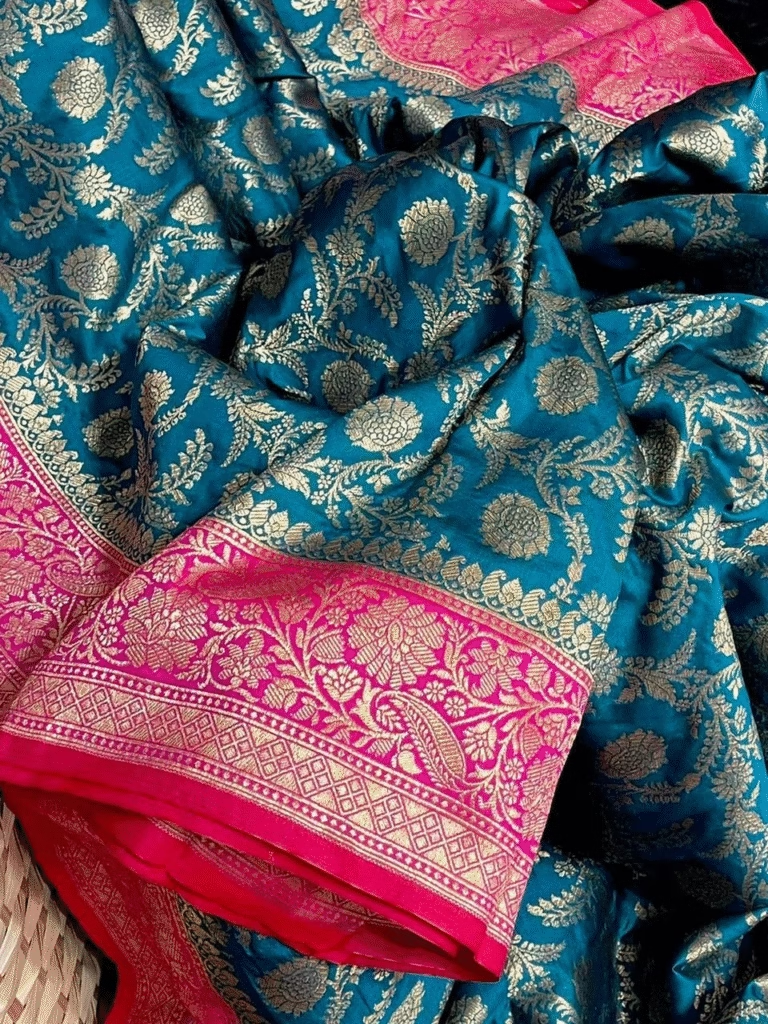
Conclusion: Timeless Elegance for the Future
Muga silk is more than a luxurious fabric. It is a living legacy—woven with sustainability, heritage, and timeless elegance.
In a world craving authenticity and conscious choices, Muga offers a meaningful alternative. It’s not just what you wear; it’s what you stand for.
So the next time you think of investing in fashion, think beyond trends. Think Muga—because every thread carries Assam’s golden legacy into the modern world.
Also Read: The Craft of Pashmina: Weaving Luxury from Nature

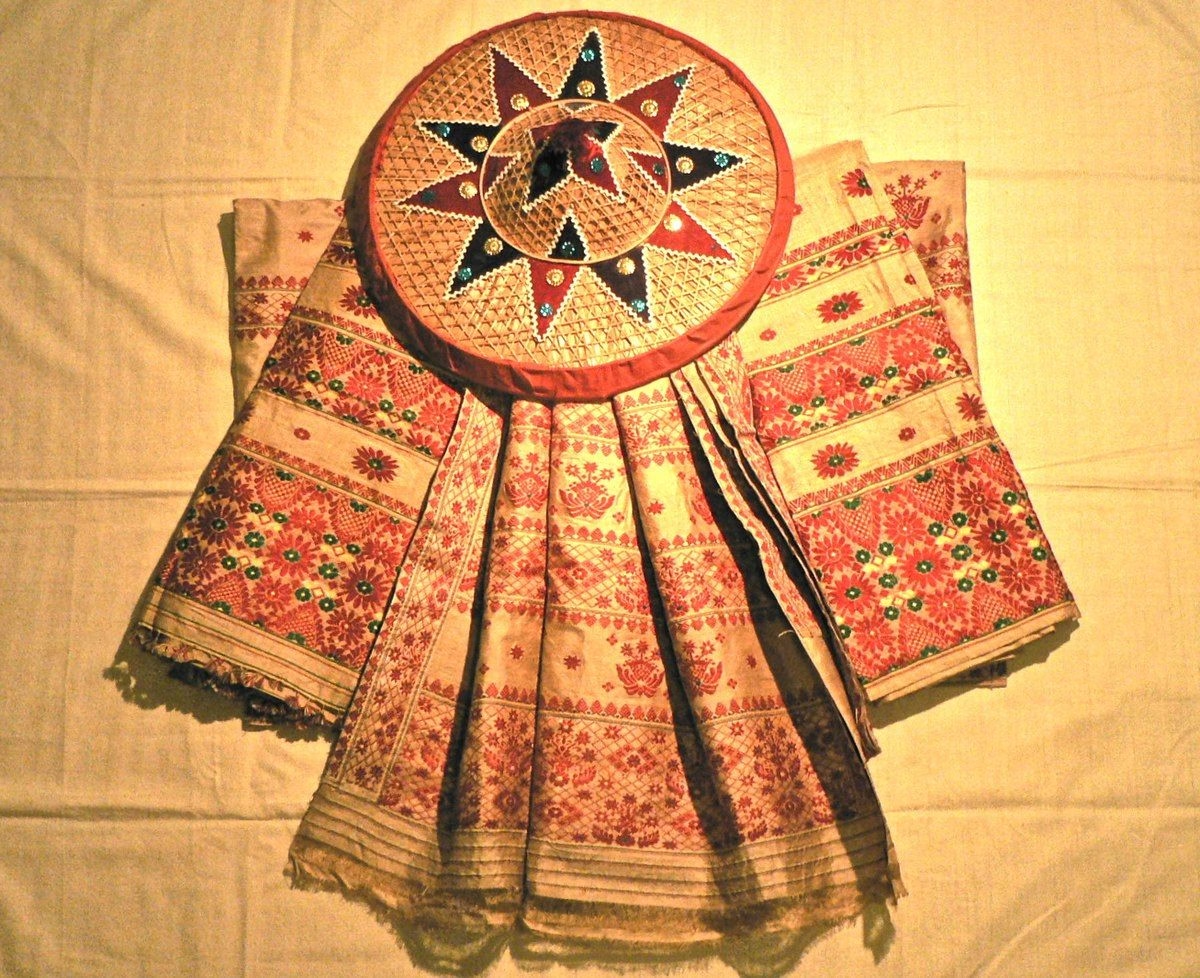
Leave a Reply